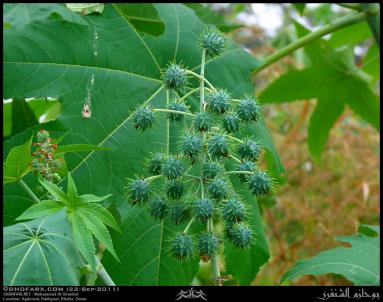
Know Our Herbs

Castor Oil Plant
English Name:- Castor Oil Plant.
Botanical Name:- Ricinus communis Linn.
Family:- EUPHORBIACEAE.
Parts- Used:- Roots, Root bark, Leaves, Flowers, Fruits, Seeds & Oil.
Habit:- A tall annual glabrous, glaucous, branched shrub looking like a small tree; Leaves broad palmatifid & serrate; Flowers unisexual.
Taste:- Acrid/Astringent.
Chemical Constituents:- Roots Contains: Resin, Tannin, Starch; Seeds Contain:- 50% oil, (Fixed oil), Protein, Ricinine, Ricin, Lipase (Enzyme), Fixed oil Contains:- Glycerides, Ricinolesis, Isoricinoleic acid, Stearic acid, Crystals of Calcium oxalate, Nitrate, Ricin is poisonous content.
Actions:- Purgative, Anti-inflammatory, Carminative, Stomachic, Aphrodisiac, Brain tonic.
Used In:- Leaves in: Disuria, Cough, Worms infestation, Fruits used in: Hepatomegaly, Spleenomegaly, Epilepsy, Piles, Asthma, Bronchitis, Skin diseases, Febrifuge, Jaundice, Eye disease, Nervous disease, Sciatica, Rheumatism and Lumbago.
Castor Oil Plant
- It is a harmless purgative and very effective in treating rheumatic and skin disorders.
- A poultice of the seeds is applied to the scrofulous sores and boils.
- The leaves heated in coconut oil can be applied on guinea-worm sores to extract worms.
- The castor seeds are used in making jewelry, particularly necklaces and bracelets.
- Castor oil is massaged over the breasts of women to increase the milk flow.
- The leaves of the plant are also used to foment the breasts.
- Regular use of castor oil promotes hair growth and cures dandruff.
- When 30 to 60 grams of castor oil taken with 250 grams of milk cures constipation.
- Chewing one castor seed daily, for seven days after menstruation, makes a women sterile.
- When consumed it expels tape worm from intestine.
- In Brazil castor oil is used for producing bio-diesel in poor rural areas.
- It is applied locally to relieve pain from arthritis, muscle and back.
Warning
Castor oil should not be consumed in cases of abdominal pain, intestinal infections, kidney infections. It should not be used in large doses in early months of pregnancy.
Specific Products
Strengthening hair oil, anti-bacterial neem dandruff oil, nourishing massage and body oil.
Disclaimer
Information on the traditional uses and properties of herbs provided on the site is for educational use only, and is not intended as medical advice. Every attempt has been made for accuracy but none is guaranteed. Many traditional uses and properties of this herb have not been validated by the FDA. If you have any serious health concern you should consult with your health care practitioner before self administering this herb.
